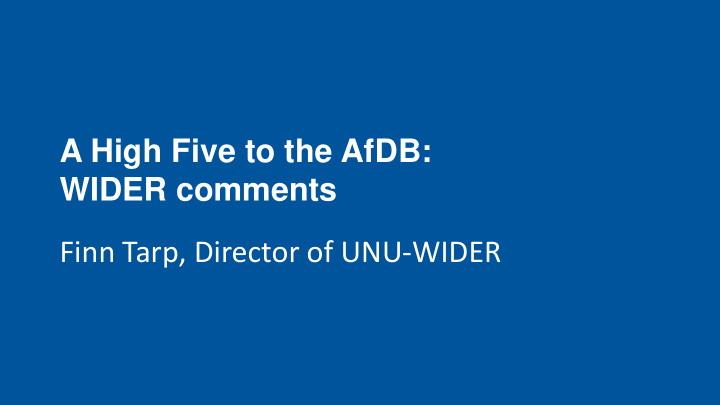



A High Five to the AfDB: WIDER comments Finn Tarp, Director of UNU-WIDER
4 2 Integrate 1 Africa Industrialise Feed Africa 5 Africa Improve quality of life for 3 the people of Africa Light up and power Africa
UNU- WIDER’s 2014 -18 work programme 3 concerns: 3 challenges : • Africa • Transformation • Gender • Inclusion • Development finance • Sustainability 3 audiences: • Policy makers • Global development community • Research community
1. Feed Africa FAO estimates: 239 million people in sub- Saharan Africa hungry/undernourished in 2010
Food and agriculture
17 country case studies show: • Most countries focused on moderating food prices and compensating consumers, rather than promoting structural change in the agricultural sector
Growth and poverty project (GAPP) • Evaluates trends in living conditions in 16 sub-Saharan African countries – corresponding to nearly 75% of the total population.
GAPP concludes: • Countries that upgrade the capabilities of small-scale farmers more likely to achieve broad-based development • Agricultural productivity growth a powerful lever for poverty reduction
2. Industrialize Africa Africa’s share of global manufacturing is smaller today than in 1980; Africa has deindustrialized since the 1980s
Learning to Compete (L2C) • The practice of industrial policy (OUP) • Case studies of government- business relationships • Special Issue of Journal of African Economies • Learning from exporting
L2C conference – industrial development and policy in Africa www1.wider.unu.edu/ L2Cconf
A strategy for industrial development • Africa can break into the global market for industrial goods – Changes in Asia; trade in tasks; industries without smokestacks • “Doing Business” not enough • Infrastructure development, skills upgrading, and a major export push essential
3. Light Up and Power Africa Energy use per person Mozambique South Africa Denmark Other countries Income per person
Which path should Africa choose? Low income Lower middle income Upper middle income High income Emissions per unit of energy use Emissions per unit of energy use Current growth path Mozambique South Africa Denmark Low carbon growth path Other countries Income per person Energy use per person Source: WIDER “Green Growth in Development” (Davies et al., 2011) Note : Energy Use and Emissions are deviations from mean logged values.
Africa's energy futures shows Renewable energy systems imperative: Four reasons: 1. Rapid declines in costs of solar and wind power 2. Untapped hydropower potential in the Nile, the Congo & the Zambeze 3. Renewable & hydropower systems: interact to ensure stable supply 4. Renewable energy systems attractive Africa: huge areas disconnected from any electricity grid
4. Integrate Africa "Regional integration is a development priority for Africa“ (AU, AfDB, UNECA)
From past to present in 1 minute • From SADCC to SADC – where do we come from? • Rationale compelling and well articulated! • But.....
Regional growth and development in Southern Africa • How to address the major political economy issues? • Major Southern Africa WIDER conference on topic coming in November
5. Improve the quality of life for Africans By 2013 GDP/capita in sub-Saharan Africa only 7.7% higher than in 1974
Open access: https://www.wider.unu.edu/publication/ growth-and-poverty-sub-saharan-africa 16 countries – 4 categories
Why not a high 10? 1. Jobs and employment (population growth) 2. Climate change 3. Gender equality 4. Aid and development finance 5. Macroeconomic policy and the management of natural resources
Africa’s population set to double to 2.5 billion by 2050: bigger than both China and India and Nigeria > US
DUCC - Development Under Climate Change • UNU- WIDER’s comprehensive country level environmental and climate change assessments show: – Deliberate long term (investment) planning critically needed for effective adaptation
Gender Equality • A special issues of the Journal of International Development • A human right and good economics • Ongoing project
Aid and development finance • ReCom: 300 researchers (59 countries) and 247 original studies (5 core themes) • Key message: – aid is effective, and has had a very respectable rate of return – including in places with weak institutional environments
Macroeconomic policy and management of natural resources • Invest resource rents in broader development: agriculture, manufacturing, integration and improved welfare • Borrow wisely: especially when tempted to overborrow on back of resource wealth • Avoid macroeconomic trouble before it strikes: especially commodity shocks
A final comment • Make investment and policy choices based on: – a sound knowledge base (the value of research) – true partnership dialogue and mutual learning • Mobilise effective international (institutional) partnerships • AfDB is making a big difference – we at UNU-WIDER hope to partner
www.wider.unu.edu Helsinki, Finland
Recommend
More recommend